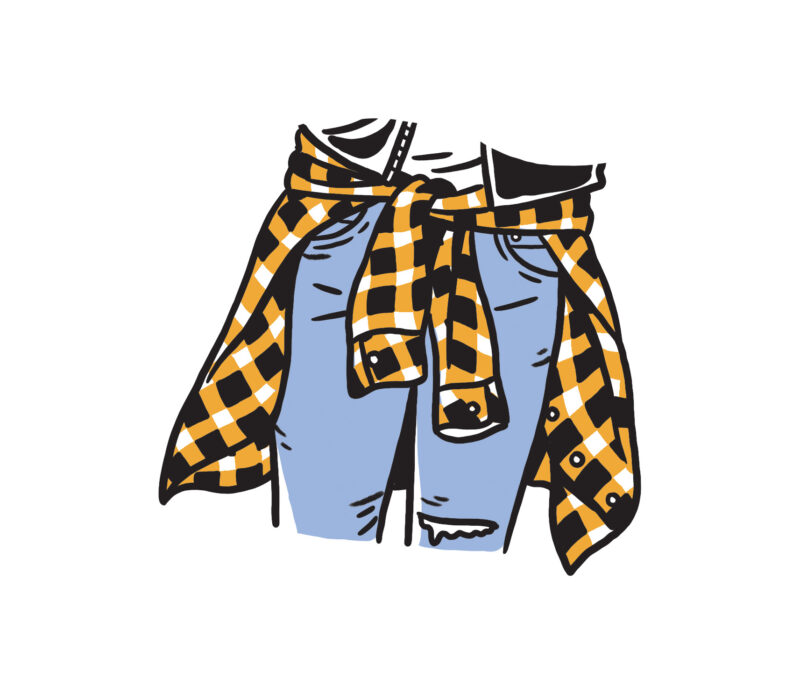FEATURES
- Ties around the waist
- Popular with girls
- Doubles as a superhero cape for your genitals
In 1993, a music video played at the end of an episode of a sitcom I liked, featuring one of the show’s stars. The song was “Nothin’ My Love Can’t Fix” by Joey Lawrence, who played the main character’s oafish older brother on NBC’s Blossom. While the tune was somewhat catchy, it was the context established by the song’s video that got me excited. The singer was just so cool, running around on a beach with a flannel shirt tied around his waist, leaning against walls, playing football, and laughing. Massive sweaters, jerseys, and jackets hung from his boyish frame like someone had haphazardly dumped their laundry onto a coatrack. But it was the flannel shirt dangling from his midsection that caught my eye. Why did he wear it like that? The style was idiosyncratic, rebellious, and an incredible tripping hazard. I thought he had everything figured out. I wanted the girls at my school to look at me the way the girls in the video looked at Joey Lawrence, but I didn’t look anything like Joey Lawrence. I looked like a scrawny ten-year-old kid with crooked teeth and dandruff. What I could do, however, was tie a flannel shirt around my waist.
My small group of friends at school had taken notice as well, and thus we had our uniform. We borrowed our oversize flannel shirts from older siblings who worshipped Kurt Cobain, and tied them around our midriffs like superhero capes for our genitals. I had recently developed a crush on a girl in my class, after noticing the soles of her LA Gear sneakers light up at a school dance. I don’t know if it was the flannel or the new confidence that wearing the flannel gave me, but after learning of my infatuation, the girl with the light-up shoes asked me to be her boyfriend. I accepted, and we immediately began avoiding each other until, at some point, she was “dating” another boy in my class. To this day, I have a recurring anxiety dream in which I suddenly remember the foggy existence of a strange girlfriend I haven’t spoken to or even thought of in months.
The shirts were helping usher us into the first stages of puberty. One kid in our clique, Korey, began telling us stories at recess. Sex stories. We’d gather around him in our flannels, by the trees at the back of the schoolyard, and he would enthrall us with his latest titillating creation. In an incredible display of groupthink, and as a testament to the importance of sex education in schools, we all ended up tacitly deciding on a couple of things: First, when Korey reached the climax of one of his stories, all the boys gathered around him would simultaneously and instantly get erections. Or, at least in my case, pretend to. And second, it was somehow agreed upon that erections were incredibly painful and distressing. So when Korey reached his big finale, we would all grab our crotches and fall to the ground, yelling, “Korey, stop it! Korey!” I still remember one of his stories. It was a short one. Korey said, “You walk into your bedroom and there’s a naked woman lying in your bed. And she’s gorgeous. She says, ‘Come to bed, baby.’ You ask her what time it is. She looks at you and says, ‘Sex o’clock.’” As soon as he said the words “Sex o’clock” we all collapsed onto the ground, holding our privates and writhing in pain, saying, “Aw, Korey! Korey, stop it!”
Joey Lawrence’s foray into pop music is now an obscure piece of trivia that only a scattering of aging millennials half remember, but its sartorial impact on one rural Ontario schoolyard in 1993 was massive. Culturally and sexually, this music video became our Ed Sullivan Show Beatles appearance, our Eras Tour. “Nothin’ My Love Can’t Fix” is not looked on as a particularly good or memorable song now, but the music was never the point for us. It was the flannel shirts, fastened about our waists like the matching kilts that Highlanders wore into battle. Together, arm in arm—or hands on crotches, as we cried out in feigned distress—we marched toward adulthood.





